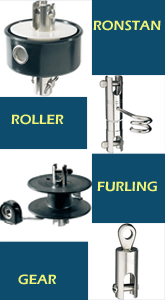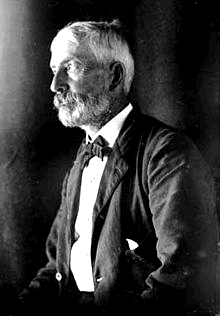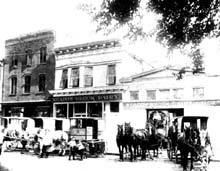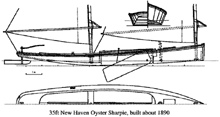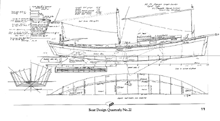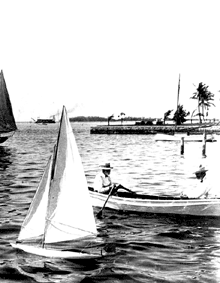
 Custom Search
|
| boat plans |
| canoe/kayak |
| electrical |
| epoxy/supplies |
| fasteners |
| gear |
| gift certificates |
| hardware |
| hatches/deckplates |
| media |
| paint/varnish |
| rope/line |
| rowing/sculling |
| sailmaking |
| sails |
| tools |
| join |
| home |
| indexes |
| classifieds |
| calendar |
| archives |
| about |
| links |
| Join Duckworks Get free newsletter CLICK HERE |
|
|
| Out There |
by Paul Austin - Dallas, Texas - USA Munroe and Egret |
 |
Ralph Munroe was born during the American Civil War, but far from the battle front in New York City, in the quiet family home. Near the end of the war, the family moved to Staten Island, where the young boy Ralph could watch the sea heave and settle, tides in and out, squalls whipping waves and then spreading overhead. Staten Island was more a part of the sea than the land. And with the life of any island, small boats created the living for fishing, moving lumber and goods and families of seamen. Ralph Munroe never forgot his boy's fascination with planking, stems and sterns and canvas sails. When he was in school, he bought his first boat for $2, probably a cross-planked skiff of heavy wood and caulk and nails.
Munroe was a social animal. It seemed every venture he entered into succeeded wildly. He had an enthusiasm for himself and what he could do, if others would just help him out. He probably would have stayed in the New York area to possibly be a banker or business tycoon as the country moved west with railroads striping Kansas, steel mills in Pennsylvania, oil rigs across Texas and Oklahoma, fortunes being made by Vanderbilt, Rockefeller and Woolworth. With the country moving west, discovering the Grand Canyon, new inventions, new towns formed by the railroad stops, gold prospectors, massive buffalo herds, wild Indians on the warpath and new states in the union, the country was bursting with enthusiasm. There were no limits to the sky. But in 1874 he met William Brickell off the coast of Staten Island. Wikipedia says this without any explanation, so I assume they met on a ship or yacht. Brickell knew of Florida, an untamed, nearly uninhabited stretch of land dividing the Gulf and the Atlantic. Only a few rough men lived there in the heat, mosquitoes an inch long, roaches, and alligators. Who would want to cut their way through jungle brush, sweating, swatting mosquitoes, stabbing snakes, staring at 10 foot long alligators who infested the low swamps by the thousands? But Brickell saw something of an opportunity. Munroe came to Florida in 1877, for the first time. He must've seen Florida as a real estate opportunity no one knew about. He probably realized he'd have to begin on the shore, the seam between sea and land where a man could live. By 1876 we know Munroe was building boats, as he built several boats for E. B. Underhill. One he named for Underhill, another for Underhill he named Cyclone. They were traditional boats. In the 1880s Munroe designed boats which were built by A. C. Brown of Tottenville, Staten Island. What is significant here is that one of these, named Allapatta, was his first design in the style of the sharpie which would later make Munroe famous.
These were sharpies, a hard-chined long narrow flat bottomed sailboat with centerboard and straight, flaring sides. They may have originated in New Haven CN, where they were used for fishing and oystering. They were easy to row, sail and build. Everything about them was long and shallow. These sharpies were 25-35 feet in length, with one sail and one man on the shorter ones, a cat ketch and two men on the longer ones. In the slight summer winds, one mast would be in the bow, the other admidships; in the harder winter winds a single mast would be stepped halfway between, just before the centerboard case, with a leg-o-mutton sprit sail. Sharpies are usually tipsy without ballast, as they do not have a deep keel. A 30 foot sharpie needs about 600 to 900 pounds of ballast on its' flat floor to sail decently. They rely on their flared topsides when sailed to windward or on a reach. They usually have unstayed, flexible masts to dump excessive wind so they don't just roll right over. Sharpies are fast downwind with their flat bottom, narrow beam and ample sail area, however with that high center of gravity, narrow beam and low aspect ratio of centerboard and rudder, they struggle to windward. With a narrow beam and centerboard case, sharpies have practically no room in a cabin. Back in New York, Munroe married Eva Hewitt in 1879. I wonder if she knew how much the wanderlust and craving for adventure had captured her husband. Now at Great Kills, Staten Island, Eva gave birth to a beloved daughter Edith Munroe. By all accounts, Munroe was dearly thrilled when Edith arrived, a child much loved and cherished. But what should have been a sentimental time became the beginning of tragedy. Edith and her mother contracted tuberculosis. No one knew how to treat tuberculosis or even what caused it. All Munroe knew to do was to move his wife, daughter, his wife's sister and their brother to Florida, to Biscayne Bay. Soon after they left, Edith died and Eve died in 1882. Her gravesite is the oldest in Miami. In 1881 Munroe introduced sharpies to Florida when he had a 33 foot sharpie he designed named Kingfish shipped to Miami. In 1886, A. C. Brown built the first Egret, and in 1887 Brown built Holgazana, another sharpie. The next year Brown built another of Munroe's sharpie designs, Nethla. By now, Florida was Munroe's permanent home. He bought some shore property of 400 acres for $400 and one of his boats. Here Munroe built a design studio with living quarters on the upper floor and a workshop on the lower floor. Munroe remarried, had a daughter and son, and settled into making a living with what was in Florida. He became an expert photographer, a salvage operator, a resort owner and operator, a regatta organizer. In 1886 Munroe designed his famous Egret, a 28 foot double-ended sharpie. By now Munroe was part entrepreneur, part promoter. He called himself Commodore, sold real estate, delivered palm trees and wrote for any magazine he could. Egret was flat-bottomed, after Munroe had made his money with round-bilged presto sharpies. With few roads in and around Miami, Munroe and Egret was busy. She had a reputation for being fast and seaworthy, running breakers, sliding among the shallow inlets, gliding up to low wood docks. But as prosperity came to Miami, eventually Egret was retired to be a dockside residence with no masts. No one knows what happened to Egret, but she may have simply been plowed under as developers filled in the low land for homes and towns. Munroe made no drawings, but he did carve a half-model; however this model doesn't seem to resemble the photographs of Egret. During the 20th century Howard Chappelle took lines off the model, making some changes of his own ideas, calling his version Dandy. In the 1980s Jon Wilson of Wooden Boat Magazine put some lines together for clean plans of an Egret, which WB still sells for $60.
Egret is as simple a cruiser to build as any 29 footer ever will be. However, the cabin is really tight with the centerboard trunk. One of the first owners of Egret to the WB plans had to enter the cabin head first and exit feet first. By 1921 Nathaniel Herreshoff renewed his friendship with Munroe. He steamed down the coast to Florida on his own power cruiser Helianthus III, to spend winters in warm waters. By now Munroe was known for his shallow draft heavy cruisers, Herreshoff was known for his lighter faster but more fragile yacht racers.
In 1923 Munroe had designed his last yacht, the Sunset, for himself. He lived 10 more years, in relative seclusion with many guests at the Barnacle, where he lived, including Alexander Graham Bell. Herreshoff spent his years after 1900 designing small boats for himself, including Coquina and the 30 footer, Pleasure. This centerboarder was his winter boat from 1925-27. It was ballasted outside the hull, as was his 14 footer, Biscayne Bay. Pleasure was first rigged as a sloop but then changed to a gunter main and yawl rig. Munroe's heavier cruisers could not race with Herreshoff's lighter yachts, so Sunset was designed to race against Pleasure. At the time I am writing this, I have not found out which one was the faster racer, but Herreshoff's extensive knowledge of hydrodynamic flow around hulls must have given Pleasure an advantage. Plans for Biscayne Bay are available from Wooden Boat Magazine for $75, a remarkabley cheap price for an authentic Herreshoff. This daysailer is included in one of the WB books, 10 Wooden Boats You Can Build. The lines in this book are not enough to build from, but the photographs cover the construction process very well. The two men were alike in talent but not personality. Munroe was an extrovert, orgainzing a yacht club among other things. Herreshoff was an engineering genuis, living a life very much to himself. There was no designer with his knowledge of scantlings, strength of material and innovations. He had no peer, and therefore few friends outside his family. He did have a great family, a close one in which none of his relatives have complained of the life they inherited. Herreshoff paid his men at the shipyard unusually well during the Depression, and they were quite loyal to him. Herreshoff spent each of his last winters in Florida until he died in 1938, back in Bristol, RI. Paul is also publishing his books on Amazon. |
|

